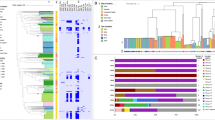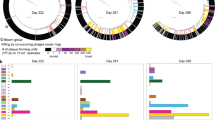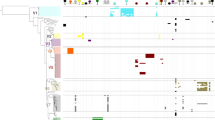Abstract
THE value of phage-typing in studying the strains of bacteria responsible for certain infections raised the question of whether phage-typing might also be valuable in epidemiological studies of diphtheria. Early investigations on this subject have already been reported1–6. Most of these earlier studies were restricted by the very small numbers of bacteriophages that had been isolated from C. diphtheriae up to that time, and of suitable sensitive indicator strains for demonstrating and propagating new phages. The decline in the incidence of diphtheria in many countries after the adoption of wide-spread prophylactic vaccination has reduced the incentive to pursue these lines of investigation. In some countries, however, diphtheria epidemics continue to be an important public health problem. This fact, together with the predominance of one biotype of C. diphtheriae in certain regions over a number of years—for example, type gravis in Romania and type intermedius in the German Democratic Republic (East Germany)7—has stimulated further studies in phage-typing as a possible means of providing more detailed information concerning the characteristics of strains involved within a prevailing biotype7–10. Arising from studies on some thousands of strains isolated over the period 1954–64 in the Diphtheria Department of the Cantacuzino Institute, Bucharest, Romania, Saragea and Maximesco proposed a provisional scheme of phage-typing of C. diphtheriae7. This involves the use of twenty-four diphtheria phage preparations by means of which nineteen lysotypes of C. diphtheriae have been recognized, not by the lysis of strains of C. diphtheriae by single phages, but on the basis of the characteristic pattern of their reactions to one or more test phages.
This is a preview of subscription content, access via your institution
Access options
Subscribe to this journal
Receive 51 print issues and online access
$199.00 per year
only $3.90 per issue
Buy this article
- Purchase on SpringerLink
- Instant access to full article PDF
Prices may be subject to local taxes which are calculated during checkout
Similar content being viewed by others
References
Keogh, E. V., Simmons, R. T., and Anderson, G., J. Path. Bact., 46, 565 (1938).
Toshach, S., Can. Publ. Hlth. J., 41, 332 (1950).
Fahey, J. E., Can. Publ. Hlth. J., 43, 167 (1952).
Hewitt, L. F., Lancet, ii, 272 (1952).
Thibaut, J., and Fredericq, CR Soc. Biol., Paris, 150, 1039 (1956).
Ortalli, A. V., Princivalle, M., and Zampieri, A., Atte IX Congr. Naz. Microbiol. Palermo, 214 (1956).
Saragea, A., and Maximesco, P., Arch. Roum. Path. Exp. Microbiol., 23, 817 (1964).
Endemann, D., and Rische, H., Colloquium über Fragen der Lysotypie Wernigerode, 173 (1960).
Rische, H., and Endemann, D., Arch. Roum. Path. Exp. Microbiol., 21, 337 (1962).
Saragea, A., Maximesco, P., Meitert, E., Diaconu, J., Marion, M., Olinesco, E., and Calab, G., Arch. Roum. Path. Exp. Microbiol., 21, 391 (1962).
Meitert, E., Bica-Popii, V., and Saragea, A., Arch. Roum. Path. Exp. Microbiol., 25, 95 (1966).
Freeman, V. I., J. Bact., 61, 673 (1951).
Author information
Authors and Affiliations
Rights and permissions
About this article
Cite this article
CARNE, H. Action of Bacteriophages obtained from Corynebacterium diphtheriae on C. ulcerans and C. ovis. Nature 217, 1066–1067 (1968). https://doi.org/10.1038/2171066b0
Received:
Revised:
Issue date:
DOI: https://doi.org/10.1038/2171066b0



